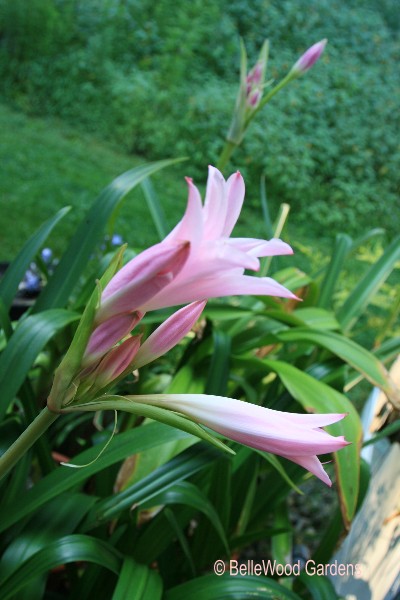
.
If you have any comments, observations, or questions about what you read here, remember you can always Contact Me
All content included on this site such as text, graphics and images is protected by U.S and international copyright law.
The compilation of all content on this site is the exclusive property of the site copyright holder.
Today I Divided a Pot of Crinum
Monday, 6 July

August 2008. That's the earliest I have any images of my pink Crinum ×powellii in bloom.
This means I've had it for at least 12 years, summering outdoors and spending winters in the greenhouse. I'm reasonably confident that it would have been potted on in that time. The congested bulbs are in a somewhat flimsy black 13-inch diameter pot. The largest bulb has a 3-foot tall pseudostem topped with a whirligig of large, strap-like leaves. There is also another largish offset, and several smaller bulbs. All these bulbs mean it is a very crowded pot, with small roots netting the surface of the soil. And a tendency towards browning of the leaf tips unless I am meticulous about watering every time it doesn't rain on a frequent schedule.
I decided that either the whole mass needed to move up into a larger pot, or the bulbs should be divided and potted individually. Actually, I don't like either option. It is awkward enough moving the current pot in and out. And I certainly do not need multiple pots with more of the same crinum. I asked "what shall I do" on the Pacific Bulbs Society. The consensus seemed to be that this crinum is hardier than I thought. It could very well survive, year round, planted in the ground here in western New Jersey. Be careful where I plant it, though, because crinum make large bulbs in large colonies. Difficult to remove them if you change your mind. And right now, early July, is a good time to do the dividing.
I read and re-read everyone's thoughtful, useful suggestions. And decided that today was the day I would unpot and separate the crinums. An advantage of the cheap, flimsy pot - I can cut the pot apart if the root-bound soil ball won't come out .
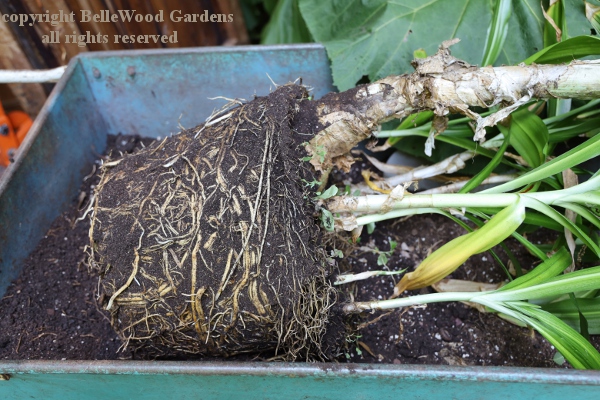
The root ball came out of the pot relatively easily. Now, to separate the bulbs.
I used two spading forks, back to back, and began by prying the smaller offsets away from each other and the two largest bulbs. There was significant root damage. Couldn't be helped.
I decided to plant the next-to-largest bulb at the bottom of the driveway
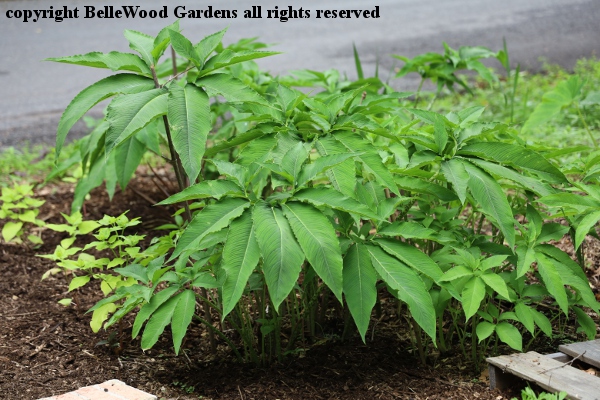
in the "tropical garden" where the Sauromatum guttatum are perennializing.
This summer I have already planted a vigorous division of Musa basjoo in that area. It will perhaps survive, with help, over the winter. I also planted a plain green elephant ear, Colocasia esculenta, which even with help would definitely not make it through the winter. With one to dig - the elephant ear - and one to protect - the banana - odds are good I will remember to protect the crinum, as I was advised by the knowledgeable people in the Pacific Bulb Society. Mulch the area, especially the first winter, is what they suggested.
This crinum bulb lost many roots in the battle to divide and separate the bulbs. I dug a good, deep, planting hole, deeper than the bulb had been in the overcrowded pot. Set the bulb in the hole and watered. partially back-filled the hole and watered again. Finished filling the hole, mulched with composted wood chips, and then watered a third time. It is supposed to rain but as my mentor John Osborne schooled me, if it isn't raining on my head, I water.
I decided to provide some shelter to counter transplant shock. To do so I set a plastic garbage can that had had the bottom removed, upside down over the pseudostem and leaves. Think of it as a large open cylinder. I steadied this protection with a stake through the handle into the ground.
Now to deal with the largest of the crinum bulbs.
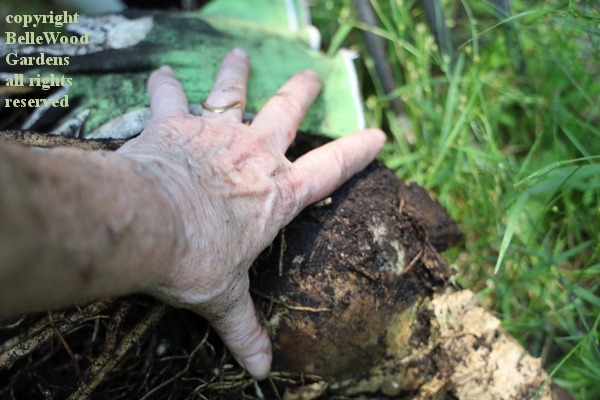
"Large" is the relevant term. This is my hand, outstretched over the bulb.
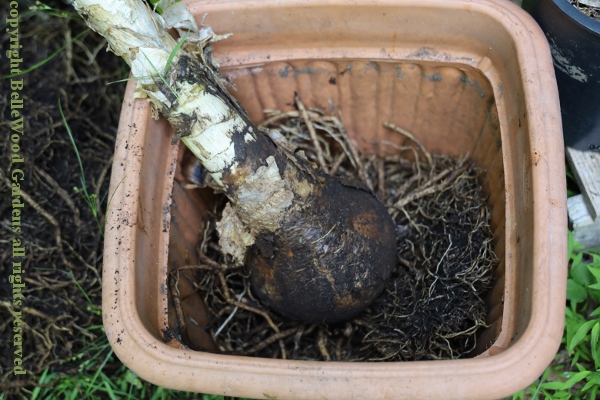
It has a pot, nicer than the black plastic one, all to itself, with some room to spread its roots.
Will it flower next month? It could, because any incipient flowers were formed last year. It is next year that's a "maybe." That will depend on how well it recovers from today's upheaval. The half-dozen small crinum offsets were potted individually. But not to keep.
From the Missouri Botanical Garden's web site:
Crinum ×powellii, commonly called swamp lily or Cape lily, is a hybrid of garden origin resulting from a cross between two South African crinums, namely, C. bulbispermum (orange river lily) and C. moorei (natal lily). This hybrid typically produces a clump of narrow, strap-shaped green leaves to 3-4 feet long and to 2-3 inches wide near the base from which rises a naked flower scape to 4-5 feet tall which is topped with umbels of 8-10 showy, fragrant, trumpet-shaped, pink flowers (each to 4 inches diameter) which bloom in succession from late summer to early autumn. Leaves are evergreen in frost free winter climates, but will die back in freezing temperatures. Long necked bulbs are large (to as much as 7 inches in diameter) with tapered necks.
Hybrid name honors C. B. Powell (1830-1904), Irish/English businessman and avid gardener who developed and introduced this bulb around 1858.
Back to Top
Back to July
Back to the main Diary Page